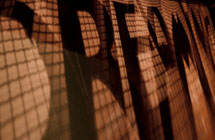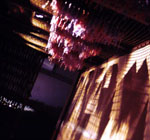 |
||
| Transcendence of Cynicism by Stephan White A former bank vault: a turntable for bullion lorries, a gold bath behind iron bars, a death certificate, shredded documents and seashore pebbles, an old wardrobe, the distant jingle of an ice-cream van, and a disused lift shaft. |
| feel |
| A castle, formerlly a prison: a simple wooden chair, a violin, train bogies filled with music cases, concave mirrors, smashed bricks. The first paragraph contains elements from work by Feiner, the second work by Horn.  Both artists share a first name, both artists are women and both women have close knowledge of the consequences of a particular brand of facism directed against Jews. Neither artist was aware of the other whilst producing her installations. The comparisons are loose, because the connection is not about intellect or pallette, but effect. The aforementioned elements are normally everyday things, but they are not "normal" in and of themselves, a simple fact that is often forgotten and a paradox at the heart of both artists' work. The physical object is signed just as arbitrarily as in language. In Horn's " Concerto for Buchenwald", empty violin cases signify unplayed music, a metaphor of death encased in the desire for life, of the destruction of the potential for beauty. It is this spatial, filmic and literary analysis of the physical signs of life, remembered as feelings, which make the work so powerful. Films, books, expostions or discussions will not in themselves create as personal a space for the sharing of emotions as this kind of super textual-installation. The beginning of this effect is that the work seems instantly comprehensible. It is not that it is understood immediately, but that it does not appear to require much effort. The work is conceptual not in the sense that it attempts to win a theorectical challenge or discussion, but in the way it simply makes present, the stuff of the world, emotional material that some have given up as inexpressible.  Once redundant and empty, an underground bank vault becomes a strange, silent room with heavy doors, gates and locks. In Feiner's "Speak Out or Consent!" installation, it makes a slightly desperate attempt to be a respectable, white washed gallery space. But when a gold bath is glimpsed behind iron bars, a terrible, daunting sense of forboding is released and a dark and difficult tale unfolds. The title and text of the work demand to be listened to and heard-there is no way to ignore her-yet there is no demand to be noticed; you enter the installation through an ordinary, domestic, front door. The demands of "Speak Out or Consent!" are a challenge to the victim in all of us. This is similar to the challenge of Horn's "Concerto for Buchenwald", where the charm and release of its intensity of subject matter lies in the fact that, despite its grandeur and inherent resistence, it will allow you to dismiss it if it does not speak to you. Its resistence is personal, and loving, because love is seen as the only triumph over any kind of facism. In both cases, if we discuss meanings, psychoanalyse and intellectualise, we miss the point: we forget to feel, to love and, most importantly for Feiner, to share and express those feelings. Hers is an art that tries to communicate rather than befuddle, confuse or obfusicate. It is ultimately unasthetic, which is not to say that it is unconcerned with beauty but that its artifice is transparent and theatrical, requiring a suspension of disbelief or, rather, a transcendence of cynicism. It is a visceral and performative transcendence that has a romantic feel. Yet by not idealising, it quietly questions common customs and assumptions about the signs of negativity in our world.  The success of Feiner's installations and video work is that they deal in this realm of the conventional, the popular, the everyday. Though the media of carefully selected and found objects, recorded in video or brought whole into the gallery, subtly transformed by context, juxtatposition and tailoring, she makes objects, signs and sounds simultaneously transform the way we see the gallery or installation space while becoming an art that is going-to -work at - home, because it evokes the familiar, the family of things, people and spaces that create the world of deepest feelings, and workmanlike because every element in a Feiner installation struggles hard for its life, for its voice. All the objects, materials, clips and photographs are made to fulfil their greatest potential, not least because of the grand scale and low budgets of her work. The process of creation of a Feiner installation plays an important part in the directness of the ambition, they are created in a constant fight against the ambivalent continuity of the world. In some ways the work is a careful collection of piquant continuity errors, which tell the tale, through observed slippages, the things that the artifice of production values was trying desperately to remove or cover up. In contrast, the video pieces present this mortal coil's most forgotten triumphs in a seamless production of beautiful images, whose ultimate challenge to the viewer is: "Why weren't you watching this?Its all under your nose". None of this occurs in a far away dreamland, a fantasy of change or transcendence. There is a direct and extremely intelligent attempt to bring to life some of the repressed feelings and thoughts we all have, but through a dialogue of the heart, not the mind. That is not to say that it lacks humour, mischief or a dark side. It speaks of pain, even torture, and sometimes it steams with anger. It is proud and cheap. It is never too subtle to be bold, never too loud to not be heard, and always felt. Heartfelt, but not romantic: it is an art of the change of now and it talks to us without voice, resonating in our bodies as feelings. Feelings sometimes terrible and uncomfortable, sometimes joyous and flippant, but feelings which we might otherwise dismiss-at our peril-as mere feelings. |